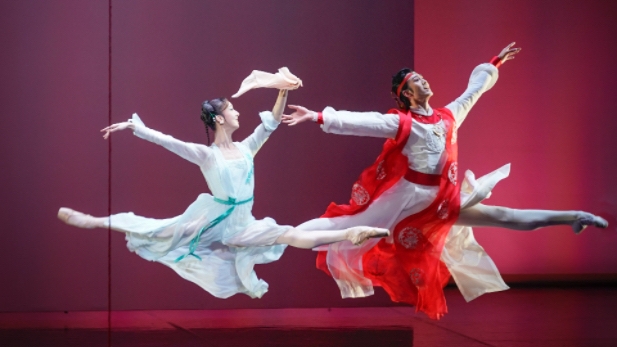The National Ballet of China ended a two-day run of its ballet version of the classic Chinese novel "A Dream of Red Mansions" Friday at the China Xinjiang International Dance Festival, with dancers saying ballet is ideal for adapting classic literature.
Qiu Yunting, who portrays Lin Daiyu, said converting one of China's Four Great Classical Novels into a ballet was the production's main draw.
To achieve this fusion, the ballet enlisted Tong Ruirui, a national first-class choreographer from China National Opera & Dance Drama Theater, to blend Chinese dance with classical ballet, Qiu said.

Qiu Yunting, a principal dancer with the National Ballet of China, is interviewed by reporters at the Urumqi Grand Theatre, northwest China's Xinjiang Uygur autonomous region, July 24, 2025. [Photo by Yang Chuanli/China.org.cn]
Qiu said the story's popularity helps audiences connect with the ballet adaptation. "The story of 'A Dream of Red Mansions' is familiar to most people, making it easier for audiences to follow," she said.
She added that ballet's delicate movements on pointe perfectly capture her character's gentle demeanor. "The audience can immediately recognize the character from her costumes and overall presence," she said.

Ma Xiaodong, a principal dancer with the National Ballet of China, is interviewed by reporters at the Urumqi Grand Theatre, northwest China's Xinjiang Uygur autonomous region, July 24, 2025. [Photo by Yang Chuanli/China.org.cn]
Ma Xiaodong, who performed Jia Baoyu, shared a similar view of ballet's power to communicate Chinese stories, saying he hopes "A Dream of Red Mansions" will tour globally.
"Ballet's universal language can bridge cultures, allowing foreigners to understand China through this art," he said.
The principal dancer, who has been with the National Ballet of China for 16 years, took on the role for the first time and said it represented his artistic growth.
"I hoped to present a fresh interpretation," he said.

A still from "A Dream of Red Mansions." [Photo provided to China.org.cn]
Ma prepared by reading the novel multiple times and studying film, television and opera adaptations. "Only by understanding the story's background and the character's state of mind in specific situations can we bring it to life on stage," he said.
Ballet's physical nature requires exaggerated movements and expressions to reach theater audiences, Ma said, calling the integration of direction, dance and music "the greatest charm of ballet."
Qiu noted the production's distinctive costumes differ from ballet's traditional tutus, with headdresses featuring unique Chinese designs. She encouraged audiences to "enjoy a feast of beauty" in the theater.
The National Ballet of China presented two works at the festival: "A Dream of Red Mansions" and the classical Russian ballet "La Bayadère."
"The emotions in 'A Dream of Red Mansions' are more restrained and delicate, while 'La Bayadère' contains more passionate segments, reflecting Eastern and Western cultural differences in expression," Qiu said.
Both dancers praised the festival's international scope. Qiu called it "a grand platform" for watching foreign performances and engaging with international artists. Ma said such events allow dance genres to "learn from each other, identify shortcomings, and advance."
The Xinjiang visit marked Qiu's first time in the region. She said that upon arrival, local dancers welcomed the company at the airport with traditional dance performances.
"They taught us Xinjiang dances, and we taught them ballet — everyone was fully engaged in the joyful exchange," she said.
Qiu said the National Ballet of China has previously tried integrating Xinjiang elements into ballet and hopes for more such collaborations.
Ma, a member of the Hui ethnic group, said he felt a special connection to Xinjiang.
"People often ask if I'm from Xinjiang. My father once considered living here, so I feel a deep connection," he said, praising the local culture and cuisine,especially the lamb skewers. "Coming here feels like coming home."
He also expressed interest in creating works that blend ballet with Xinjiang dance, particularly the Dolan style.
"I particularly love the dynamic Dolan dance of Xinjiang and hope to learn it someday," he said.


 Share:
Share: 




 京公網安備 11010802027341號
京公網安備 11010802027341號